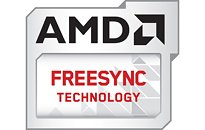- Joined
- Oct 9, 2007
- Messages
- 47,884 (7.38/day)
- Location
- Dublin, Ireland
| System Name | RBMK-1000 |
|---|---|
| Processor | AMD Ryzen 7 5700G |
| Motherboard | Gigabyte B550 AORUS Elite V2 |
| Cooling | DeepCool Gammax L240 V2 |
| Memory | 2x 16GB DDR4-3200 |
| Video Card(s) | Galax RTX 4070 Ti EX |
| Storage | Samsung 990 1TB |
| Display(s) | BenQ 1440p 60 Hz 27-inch |
| Case | Corsair Carbide 100R |
| Audio Device(s) | ASUS SupremeFX S1220A |
| Power Supply | Cooler Master MWE Gold 650W |
| Mouse | ASUS ROG Strix Impact |
| Keyboard | Gamdias Hermes E2 |
| Software | Windows 11 Pro |
AMD and Samsung today announced support for Radeon FreeSync technology in the new Samsung QLED 55" to 82" TV range, bringing the ultimate, ultrawide 4K gaming experience to an entirely new format - big screen TVs. Samsung is the first company to utilize industry-leading Radeon FreeSync adaptive refresh technology for stutter-free gaming inside a consumer television set. With High Dynamic Range (HDR) support up to 1000nits and stunning picture quality, Samsung's QLED displays allow gamers to experience strikingly high refresh rates and low latency on TVs at a variety of price points and screen sizes ranging from 55" to 82" creating a single display for all their home entertainment needs.
Over the past three years, Radeon FreeSync technology has driven widespread adoption and become the industry's most selected solution for smooth gaming. Earlier this year, AMD expanded the ecosystem by propelling tear-free gameplay beyond the PC with the launch of support for FreeSync technology in Microsoft's Xbox One S and Xbox One X consoles in early March. With more than 250 compatible displays offered by more than 20 partners, this is more than double the availability of competing technology.


"Whether you're a console or PC gamer, playing on a PC display or your living room TV, Radeon FreeSync technology powers exceptional stutter-free gaming experiences," said Scott Herkelman, vice president and general manager, Radeon Technologies Group, AMD. "We launched FreeSync technology with a mission to end frame tearing and dropped frames, as well as improve the experience for gamers around the world. With Samsung's FreeSync technology QLED TVs, extra smooth gameplay visuals have never been so accessible, and never in such a large and appealing format."

"From the beginning, Samsung has embraced Radeon FreeSync technology and the commitment from AMD to deliver technologies based on open standards that enhance the gaming experience," said Chu Jongsuk, senior vice president at Samsung. "Our users demand the absolute best in visual quality, and that extends to smooth gaming low latency. We're thrilled to bring the power of Radeon FreeSync technology to Samsung TVs for players around the world."
"AMD and Microsoft have a long history of innovation, collaborating on hardware and software to bring gamers the best possible experiences," said Matthew Lapsen, general manager, Xbox Console Marketing. "With FreeSync technology support for our Xbox One platform, AMD and Microsoft brought a critical gaming technology to a broader base of gamers. We're offering a whole new caliber of smooth-looking gameplay to players on Xbox One S and Xbox One X."

FreeSync technology for Samsung's 2018 QLED TV range is available today for the QLED 55" - 82" models and the NU8000 / NU8500 55" - 82" Series. This will be delivered as part of an automatic Gamer Mode update.
View at TechPowerUp Main Site
Over the past three years, Radeon FreeSync technology has driven widespread adoption and become the industry's most selected solution for smooth gaming. Earlier this year, AMD expanded the ecosystem by propelling tear-free gameplay beyond the PC with the launch of support for FreeSync technology in Microsoft's Xbox One S and Xbox One X consoles in early March. With more than 250 compatible displays offered by more than 20 partners, this is more than double the availability of competing technology.


"Whether you're a console or PC gamer, playing on a PC display or your living room TV, Radeon FreeSync technology powers exceptional stutter-free gaming experiences," said Scott Herkelman, vice president and general manager, Radeon Technologies Group, AMD. "We launched FreeSync technology with a mission to end frame tearing and dropped frames, as well as improve the experience for gamers around the world. With Samsung's FreeSync technology QLED TVs, extra smooth gameplay visuals have never been so accessible, and never in such a large and appealing format."

"From the beginning, Samsung has embraced Radeon FreeSync technology and the commitment from AMD to deliver technologies based on open standards that enhance the gaming experience," said Chu Jongsuk, senior vice president at Samsung. "Our users demand the absolute best in visual quality, and that extends to smooth gaming low latency. We're thrilled to bring the power of Radeon FreeSync technology to Samsung TVs for players around the world."
"AMD and Microsoft have a long history of innovation, collaborating on hardware and software to bring gamers the best possible experiences," said Matthew Lapsen, general manager, Xbox Console Marketing. "With FreeSync technology support for our Xbox One platform, AMD and Microsoft brought a critical gaming technology to a broader base of gamers. We're offering a whole new caliber of smooth-looking gameplay to players on Xbox One S and Xbox One X."

FreeSync technology for Samsung's 2018 QLED TV range is available today for the QLED 55" - 82" models and the NU8000 / NU8500 55" - 82" Series. This will be delivered as part of an automatic Gamer Mode update.
View at TechPowerUp Main Site




 . Nvidia just doesn't want people to know that.
. Nvidia just doesn't want people to know that.